City of Hull Tramways /Hull Corporation Tramways
History
Prior to the corporation becoming a tramway owner/operator, there were two standard-gauge tramways operating in Hull, both owned by companies. The earliest of these was a horse tramway, owned and operated by the Hull Street Tramways Company, which opened for business on the 5th January 1874, and which, at its maximum, operated just shy of 11 miles of tramway. The second was a steam tramway, owned and operated by the Drypool and Marfleet Steam Tramways Company, which opened on the 21st May 1889, but only comprised a single line 1.34 miles long.
By the 1890s, both these tramways were in poor physical and financial health, the horse tramway having been in the hands of a liquidator since January 1890, and the steam tramway struggling, having made continual losses since opening, principally because it went, in the words of the locals, from "nowhere to nowhere". Both concerns had been hoping to rid themselves of their loss-making tramways by selling them to the corporation, the HSTCo forlornly hoping to persuade the corporation to take over the tramway and rebuild it, then lease its operation to a new company that the HSTCo would set up.
The corporation, however, was in no hurry to spend its money, and was, in spite of constant grumblings from the travelling public, happy to bide its time. The corporation very much had the whip hand as it had the right — under the Tramways Act of 1870 — to compulsorily purchase both tramways 21 years after the various enabling acts, which in the case of the majority of the horse tramway lines was in August 1893. Unfortunately, this meant that the horse tramway became ever more decrepit, as there was no way that the company could justify further investment in the tramway with the spectre of compulsory purchase looming, given that the corporation resolutely refused to either waive its right to purchase the tramway, or to rebuild it and lease it to the company.
By 1894, the liquidator had clearly had enough of the ongoing impasse, and after a failed attempt to sell the undertaking, he once again offered the horse-tramway system to the corporation; this time the corporation agreed — on the 1st August 1895 — but only after a great deal of haggling, in which the price was driven down to a level that did not best please the debenture holders, who were the main creditors of the HSTCo and who stood to lose money.
The corporation now set about planning its new tramway system, which it intended to be worked electrically, though it had yet to decide whether it would operate the system itself or lease it to a company, an issue that was highly contentious at the time, and not just in Hull. A fully worked-up scheme was submitted to parliament on the 1st February 1896, with powers to take-over the existing horse tramway, convert it to whatever mode of traction it saw fit, and to build a series of additional lines being granted to the corporation on the 26th July 1896 by the Hull Corporation Tramways Order, which was passed into law under the umbrella of the Tramways Orders Confirmation (No. 1) Act, 1896.
The corporation formally took over the horse tramway on the 15th October 1896, leasing its operation to a local cab proprietor, a Mr W. Nettleton. The corporation now spent a great deal of time discussing municipal operation versus leasing, whilst soliciting tenders for the reconstruction and operation of the tramway from all and sundry. None of the proposals appear to have found favour, and in the end, the corporation decided to build and operate the system itself, selecting overhead electric traction over various other forms of electric pick up. Whilst all this was going on, Hull was raised to city status on the the 6th July 1897.
The first rail of the new electric system was ceremonially laid on the 9th June 1898, the first electric services commencing on the 5th July 1899 over the reconstructed tramway along Anlaby Road and Hessle Road. Meanwhile, Mr Nettleton continued to operate the remaining horse tramway services until the last one was withdrawn on the 30th September 1899, though some sources state that this was actually in November.
The corporation now found the time to turn its attention to the steam tramway, quickly reaching agreement with the D&MSTCo (on the 9th November 1899) to purchase the tramway. The company continued to run the steam trams until the formal handover took place on the 31st January 1900, whereupon the existing staff were transferred to the corporation, with everything essentially continuing as before.
The corporation duly obtained powers to electrify and extend the steam line on the 6th August 1900 via the Hull Corporation Tramways Order, which was passed into law as part of the Tramways Orders Confirmation (No. 3) Act, 1900. With electrification imminent, the corporation naturally minimised expenditure on the steam tram engines, which by January 1901 had dwindled to just two operational vehicles; as these were insufficient to provide a public service, the trams were promptly withdrawn, the last service running on the 13th January 1901.
The remaining electric lines of those initially authorised were all completed during 1900: Holderness Road (10th April), Spring Bank (2nd June), Queens Road (8th October) and Beverley Road (8th December 1900). The corporation was, however, not slow in expanding the system, obtaining powers for further extensions on the 26th July 1901 and on the 14th August 1903, under the Kingston-upon-Hull Corporation Acts of 1901 and 1903, respectively. During 1903, the Spring Bank line was extended to Cottingham Road (on the 19th June), and the Holderness Road line was extended to Aberdeen Street (27th March), with new lines also opening through the Old Town to Victoria Pier (20th October) and along Hedon Road (17th December).
Further powers for tramway extensions, as well as to run motor omnibuses in connection with the tramway, were granted on the 4th August 1906 under the Kingston-upon-Hull Corporation Act, 1906. This led to the opening of a connecting line from Alfred Gelder Street, across Drypool Bridge and along Clarence Street (29th July 1907). By this time the tramcar fleet stood at circa 116 vehicles, with a programme of top-covering in progress, and was overall in a very healthy financial state, making significant profits, paying down the loans and interest, and making contributions to rates relief.
The first motor omnibus services were introduced on the 29th July 1909 out to Stoneferry Green; although they lasted until the 5th April 1912, they were not a financial success.
Powers for yet more extensions followed on the 18th August 1911 under the Kingston-upon-Hull Corporation Act, 1911. The Hedon Road line was extended to Marfleet Avenue (29th December 1912), the Spring Bank line to Walton Street (9th October 1913), and the Hessle Road line to Pickering Park Gates (16th February 1914); a short connecting line was also constructed. Although further extensions were authorised on the 2nd July 1915 under the Hull Corporation Tramways Order 1915, which formed part of the Tramways Orders Confirmation Act, 1915, the outbreak of the Great War would prevent any further progress.
Like most tramways, the Great War placed the system under great strain, initially through the loss of significant numbers of men (and their skills) and subsequently due to an inability to source materials and spares, all of which led to insufficient maintenance and the withdrawal of some services. Fortunately, the corporation had recently added 23 new tramcars to the fleet (in 1912), with another 19 on the way, which despite the outbreak of hostilities, were still delivered in 1915, taking the fleet to 180 cars.
The severe problems caused by the loss of men to the armed services was ultimately solved by employing women, a step that Hull seems to have been particularly reluctant to take, even when others such as Glasgow Corporation had declared it a success. The corporation's hand was, however, eventually forced by the circumstances, conductresses being taken on in late 1915, and eventually motorwomen (in December 1917/January 1918) and inspectresses too.
The lack of adequate maintenance and the heavy loadings, coupled with enemy action, saw the system emerge from the conflict in badly run-down condition. Not only was there a huge backlog of work, but the system had also incurred its first losses (in 1916/1917 and 1919/1920), despite carrying record numbers of passengers; this was in large measure due to the council's insistence on very low fares for the travelling public, coupled with free travel for all manner of sub-groups, a policy that was far more generous than almost every other tramway system.
Despite these exigencies, after the war the corporation quickly set about putting the system in order, instituting a programme of track replacement that would last for several years, and quickly opening a new extension along Cottingham Road to Newland Park (7th July 1919). By 1921, the system was once again making a profit, having almost paid off all the original debt, and with a reserve fund of almost £138,000. The same year the corporation tentatively dipped its toes once again into motorbus operation, using them to service districts that were not served by the trams; expansion was, however, slow, and loss-making, the fleet comprising just 29 vehicles by 1927.
In 1923, the corporation decided to expand the tramway system yet further, obtaining powers to this end on the 1st August 1924 under the Kingston upon Hull Corporation Act, 1924. The extensions were opened over the course of the next three years as follows: Holderness Road line to Ings Lane (7th September 1925); Newland Avenue to Cottingham Road, Spring Bank West to Chanterlands Avenue, and Anlaby Road to Pickering Road (5th October 1925; Beverley Road to Endike Lane (12th July 1927); Chanterlands Avenue to Newland Avenue (3rd January 1927); and Hessle Road to Pickering Road (14th July 1927). This brought the system to its final size of circa 20.5 miles. From the city centre, lines radiated southwestwards along Hessle Road to a terminus at Pickering Road; westwards along Anlaby Road to a terminus at Pickering Road (with a short spur along Boothferry Road) and along Spring Bank and Spring Bank West to a terminus at Walton Street; northwards along Beverley Road to a terminus at Endike Lane, with a line branching off westwards along Newland Avenue to a terminus at Cottingham Road; northeastwards along Holderness Road to a terminus at Ings Lane; eastwards along Hedon Road to a terminus at Marfleet Avenue; and southwards through Old Town to Victoria Pier. There were also two lines running northwards from the Spring Bank line to the Newland Avenue line, one along Chanterlands Avenue and the other along Queens Road. In addition, there were a number of connecting lines in the city centre, including one eastwards over Drypool Bridge and along Clarence Street to eventually join the Holderness Road line.
Despite the opening of new extensions, all was far from well within the enterprise, with high unemployment – from 1924 onwards – causing ridership to plummet, the National Strike in 1926 badly impacting profitability, and to cap it all, a badly deteriorating relationship between certain influential individuals on the council and the tramway's management. The problems with the council extended back to 1919, when the then council instigated a report into what it felt was a poorly run tramway, and with some justification, the outcome of which was a reorganisation and a new General Manager. As a consequence of all these factors, the tramway started to struggle, with the buses making continual losses that the tramway had to absorb, and the council repeatedly ignoring the advice of the General Manager, particularly in respect of low fares, the former on more than one occasion forcing through changes that would prove to adversely affect the tramway's financial viability, exactly as the General Manager had said they would.
The bad blood between the council and the tramway's new management seems to have stemmed from the General Manager's handling of the General Strike in 1926, with certain vocal individuals on the council accusing him of all manner or misdemeanours, and once again, asserting that the tramway was badly run. This situation deteriorated to the point where the hounding of the management, and the General Manager in particular, entered the public domain, where it was then allowed to play out for many months. Despite the Tramways Committee having conducted a thorough investigation, which found that there was no substance to the allegations, the council simply over-rode the committee, dismissing the General Manager and two others in late 1930.
Quite why a small number of vindictive individuals were allowed to repeatedly attack their own tramway's management for several years on end, initially within the confines of the council and corporation, but ultimately very publicly, beggars belief, and one wonders just what effect it had on the overall operation of the department.
In July 1930, the name of the department was changed to Hull Corporation Transport, no doubt to reflect the increasing proportion of services delivered by motorbuses.
The first tramway casualty of the worsening financial situation was the Old Town line to Victoria Pier, which was closed on the 5th September 1931, just one month before the manager (a replacement for the one dismissed) recommended that the tramway be abandoned, and that expenditure upon it be kept to a minimum, this despite the fact that bus operation was still incurring large losses.
The first blows to the tramway took place on the 29th July 1934 with the implementation of a coordination agreement between the corporation and East Yorkshire Motor Services (a motorbus operator), which saw tram services along numerous lines being withdrawn the day before. The lines were: Newland Avenue to Cottingham Road, Spring Bank West to Chanterlands Avenue North, Anlaby Road beyond Wheeler Street, and Hessle Road beyond Dairycoates, most of which were not even 10 years old.
On the 14th July 1936, the corporation, at the second attempt, obtained powers to operate trolleybuses; these were granted under the Kingston upon Hull Corporation Act, 1936, an act which also authorised the abandonment of the tramway. The first trolleybus service ran on the 23rd July 1937, tram services along Newland Avenue and Spring Bank being withdrawn the following day. The rest of the tramway system gradually followed, Hedon Road on the 1st January 1938, Beverley Road on the 3rd September 1938 and Holderness Road on the 17th February 1940. Despite the Second World War still raging, the Anlaby Road line was closed on the 5th September 1942, leaving just the Hessle Road line, which survived until the 30th June 1945.
The tramway was a great success up until the late 1920s, having paid off its debts and having contributed over £250,000 to rates relief by 1928, though on the debit side it palpably failed to modernise its aging tramcar fleet after the Great War. From the mid-1920s onwards, however, it was plagued by council interference, and after having incurred a large debt building extensions during the 1920s that ought to have lasted at least 15 if not 20 years, it then suffered a change of management and a complete volt-a-face, having to spend yet more money replacing the trams with motorbuses and trolleybuses.
Uniforms
Although Hull Corporation became a horse tramway owner in 1896, it did not operate the services itself, instead leasing them to a local operator, W Nettleton, surviving photographs strongly suggesting that uniforms were not worn (see link). Although the corporation did operate steam services for just under one year, having taking over the Drypool and Marfleet Steam Tramway, there is currently no evidence to suggest that uniforms were issued to the staff working these services (see link).
Staff on the newly inaugurated electric services were issued with single-breasted jackets with five buttons (almost certainly in brass and carrying the Hull municipal device — see link), three waist-level flap pockets and stand-up collars. The uniforms were in blue serge piped in red, and with the exception of the buttons, did not carry any insignia. The caps, which were in a kepi style, carried an oval cloth cap badge piped in red, which bore the title 'HULL CITY TRAMS' in red embroidered block capitals. These caps do not, however, appear to have lasted very long, being quickly displaced by drooping-peak caps; the new caps carried a one-piece 'HCT' initials cap badge (almost certainly in brass), with an employee number (in individual brass numerals) worn below. Although the drooping-peak caps were in turn superseded by tensioned-crown peaked caps, probably in the late Edwardian era, they continued to carry the same insignia as their immediate predecessors.
A more modern style of jacket was certainly introduced in later years, possibly just after the Great War, and though still single-breasted, it now had two breast pockets (with button closures), lapels and epaulettes (again with button closures). A new cap badge was also introduced, probably in 1919 when the name of the enterprise was officially changed to Hull Corporation Tramways; the badge comprised the Hull municipal device within a garter containing the full system title, 'HULL CORPORATION TRAMWAYS'. The employee number, previously worn on the cap, was probably moved to the jacket epaulettes at the same time the new cap badge was introduced. The cap badge has survived in both brass and nickel, suggesting that a transition was at some point made from one to the other, more than likely from the former to the latter. Although the general form of the cap badge remained the same, caps issued after 1932 presumably bore badges bearing the title 'HULL CORPORATION TRANSPORT', the name of the undertaking having been changed that year.
Tramcar crews were also issued with long, double-breasted greatcoats with six pairs of buttons and high, fold-over collars; in the early years these garments were embellished with Hull municipal-device buttons on the coat cuffs. Other than the buttons, the greatcoats bore no markings or badges. During the Great War, male staff sometimes wore greatcoats with plain buttons.
In the early years, timekeepers and depot foremen wore blue cloth uniforms piped in red, comprising double-breasted jackets with four pairs buttons, three waist-level flap pockets, an open breast pocket, and lapels; the collars bore their grade — 'Timekeeper' or 'Foreman' — in embroidered script lettering. Their drooping-peak caps bore a large silver badge, almost naval in appearance, which bore the grade, horizontally, in silver thread, across three lines, e.g., 'CITY FOREMAN TRAMS'. By the time of the Great War, the drooping-peak caps had been superseded by tensioned-crown peaked caps; whilst still bearing embroidered cap badges, these now comprised curved lettering system initials above the grade, over two lines, e.g., 'H C T TIMEKEEPER'. For timekeepers (at least), a more traditional tramway uniform was also introduced; this comprised a single-breasted jacket (with hidden buttons, or more likely a hook and eye affair), edged in a finer material than the main body of the jacket, and with stand-up collars; the latter probably bore the grade — 'Timekeeper' — in embroidered script lettering, though this cannot be made out with certainty on the surviving photographs. Foremen were eventually issued with single-breasted jackets bearing lapels and epaulettes; the collars of these jackets again bore the grade in embroidered script lettering.
Inspectors initially wore an elaborate uniform comprising a single-breasted, three-quarter-length jacket with hook and eye fasteners, ostentatious braiding (on the front and sleeves) and stand-up collars; the latter bore the grade 'Inspector' in embroidered script lettering. The cap was of the drooping-peak type with a glossy peak (with braiding) topped by a pom pom; the embroidered cap badge comprised a wreath surrounding the title 'CITY INSPECTOR TRAMS', on three lines. It is likely that inspectors uniforms and caps were also changed to the type worn by timekeepers, though when this occurred is unclear.
In common with many UK tramway systems, women were employed during the Great War — and for a short time afterwards — to replace male staff lost to the armed services, initially as conductresses, but later as motorwomen and inspectresses. These ladies were issued with single-breasted, tailored jackets with five buttons, four pockets (with button closures), a waist belt with button fastening, epaulettes and lapels. Long matching skirts were also worn. As was the case with male uniforms, no insignia other than the buttons was carried. Occasional photographs have survived which show women wearing a different style of jacket, still single breasted, but with two waist-level pockets and high-fold-over collars; it is unclear whether one style succeeded the other or whether they were intended for different grades. Caps were of the wide-crown peaked type; they bore the same insignia as the men's caps.
The ladies were also issued with long, single-breasted topcoats with six buttons, epaulettes and high, fold-over collars; these garments appear not to have borne any badges.
Female staff were also employed during the Second World War, however, the only photograph that I have been able to find is of a conductress in a double-breasted topcoat with lapels (devoid of insignia), so details of the uniform worn underneath, save for trousers, remain unknown. Headgear took the form of a baggy cap with a glossy peak; this bore the standard later-period round cap badge, presumably the 'Transport' pattern.
Further reading
For more information on Hull's tramways, see: 'A History of Kingston Upon Hull's Tramways' by Malcolm Wells; Adam Gordon Publishing (2012).
Images
Motormen and conductors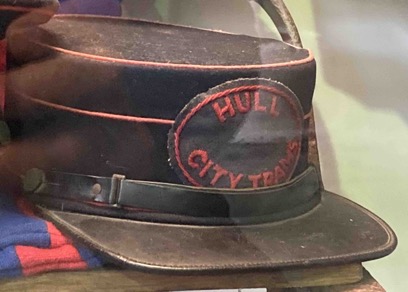
An early Hull City Tramways kepi-style cap. Hull Street Life Museum.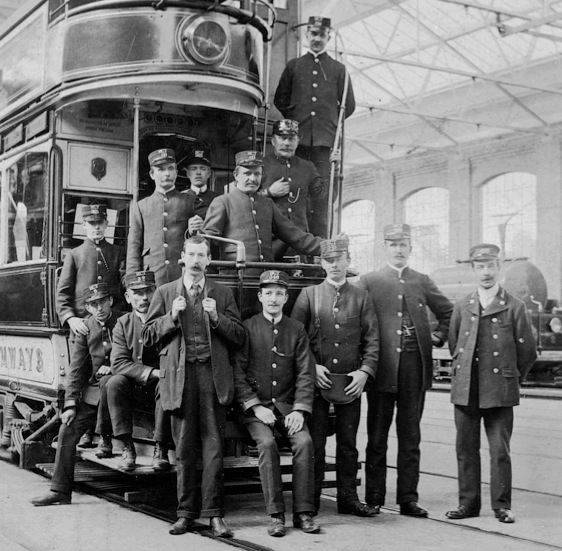
An excellent photograph taken inside the Cottingham Road Depot showing an array of tramcar staff (motormen and conductors), as well as a senior-grade employee (far right), who is possibly a Depot Foreman - photo undated, but probably taken around the turn of the century. Photograph courtesy of Paul Gibson (see link).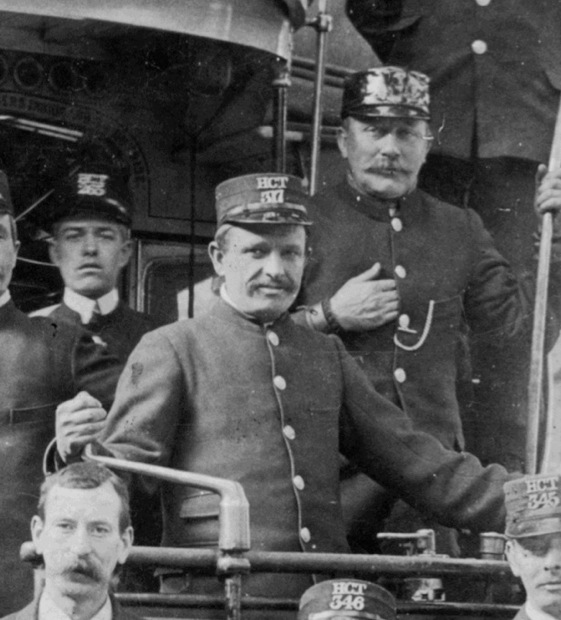
An enlargement of the above photograph, showing details of the uniform, including the drooping-peak caps, which bore a one-piece 'HCT' initials badge above an employee number. The individual standing to the right of the motorman appears to be wearing a waterproof cover on his cap. Photograph courtesy of Paul Gibson (see link).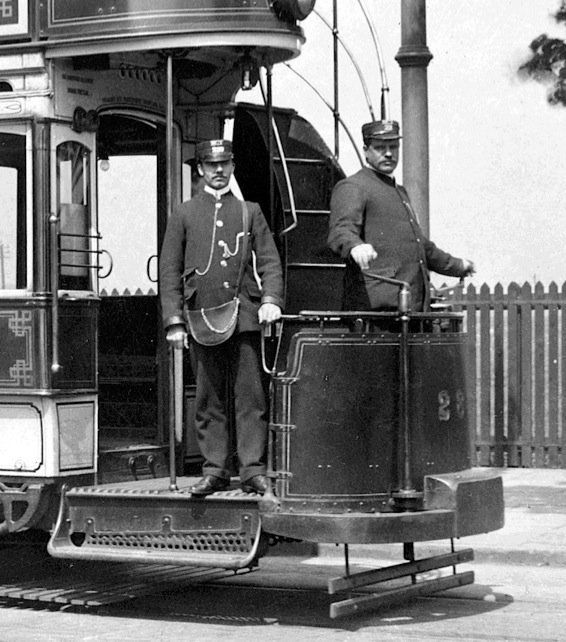
The crew of Tramcar No 28 in Anlaby Road near Wheeler Street Depot in 1908. Both men are wearing drooping-peak caps, which by this time were quite old fashioned. Photograph courtesy of Paul Gibson (see link).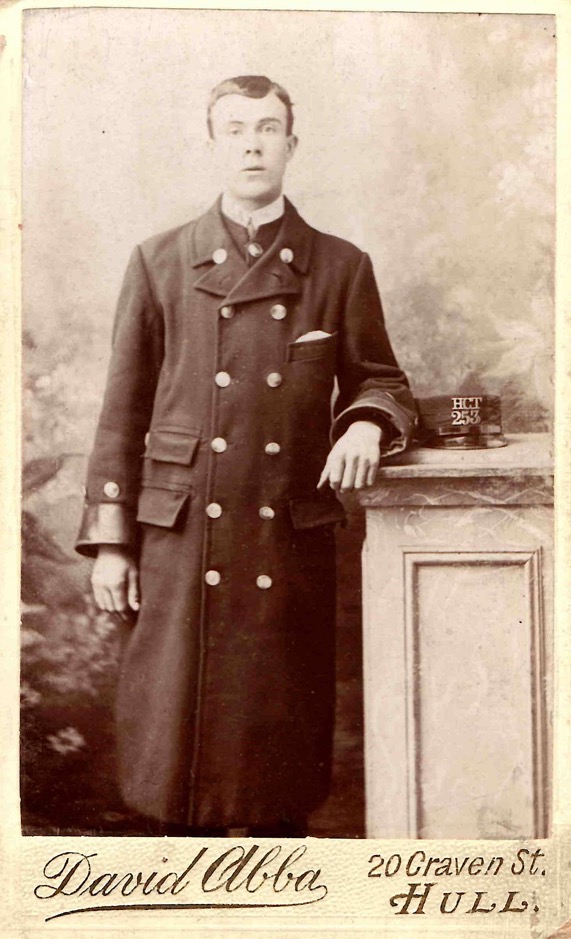
Hull City Tramways Employee No 253, James Lawrence Parker — photo undated, but probably taken in the mid-to-late Edwardian era. James was born in 1886, and worked on the trams both before and after the Great War, dying in 1968. He is wearing a long, heavy-duty greatcoat, so he may well have been a motorman at this point in his career. Photo courtesy of James Parker's grandson, George Baker.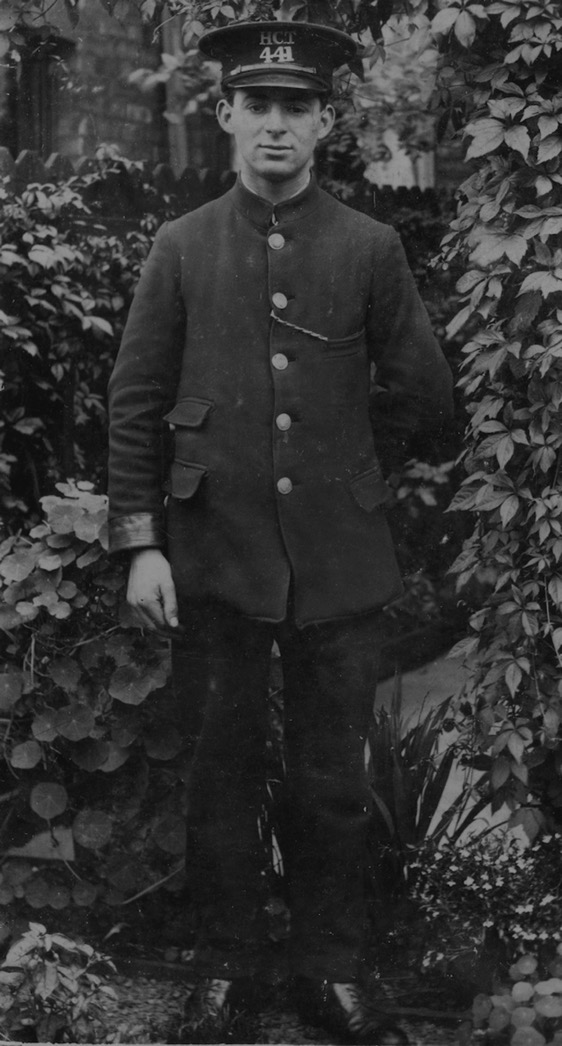
Hull tramwayman No 441 poses in his somewhat ill-fitting uniform and a tensioned-crown peaked cap, for what was undoubtedly a family snap — photo undated, but probably taken just prior to the Great War. Author's Collection.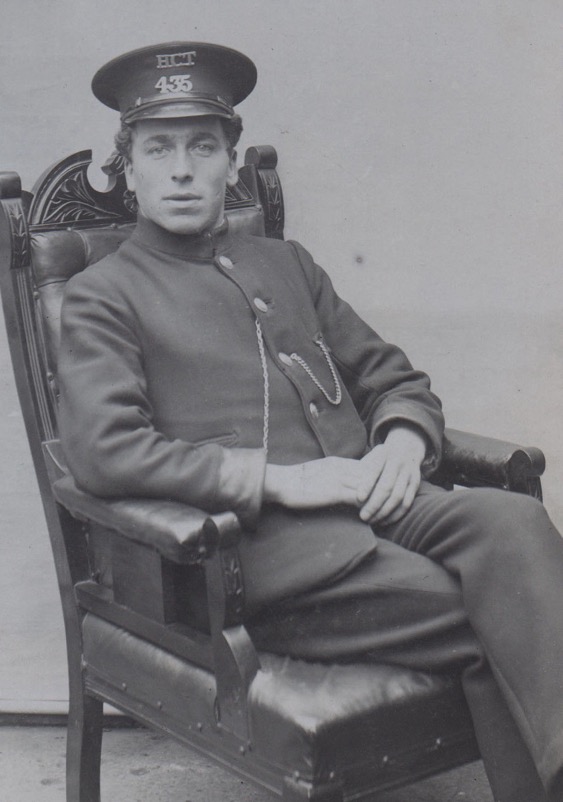
Hull City Tramways Employee No 435 in a rather unusual seated pose – photo undated, but probably taken in the late Edwardian or pre-war years. Apart from the cap badges, the rest of the uniform is devoid of insignia. Photo courtesy of the Stephen Howarth Collection.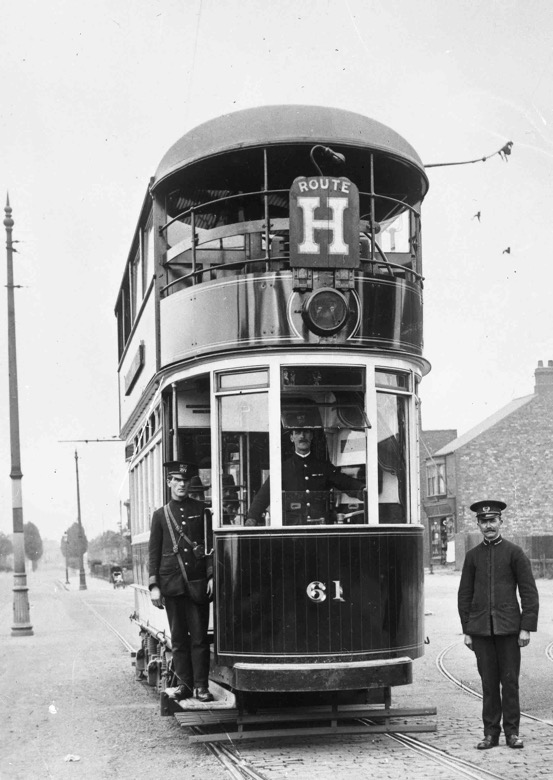
The crew of what looks to be a newly vestibuled and outshopped Tramcar No 61, plus a timekeeper, pose for the cameraman at the Holderness Road terminus. Although the photo is undated, the pristine looking vestibule suggests that it was taken directly after fitting, i.e., June 1915. Photo courtesy of the National Tramway Museum. 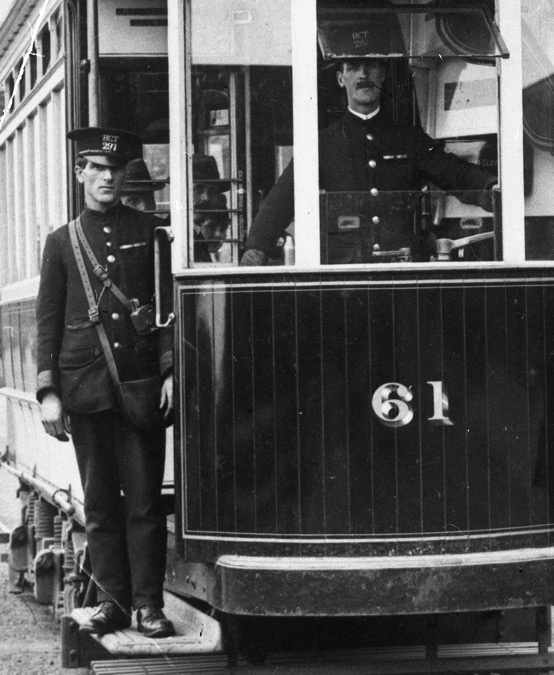
An enlargement of the above photograph showing the conductor and the motorman, Employees No 297 and 267.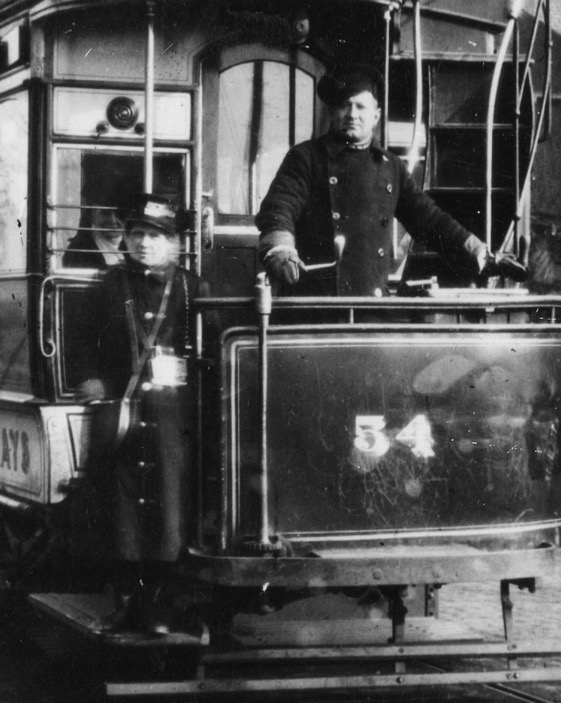
A conductress (who has unfortunately moved during the exposure) and a motorman with Tramcar No 54 on Hedon Road (Route M/A) in 1915. The motorman's greatcoat buttons are plain (i.e., unmarked), presumably due to supply problems during the conflict. Author's Collection.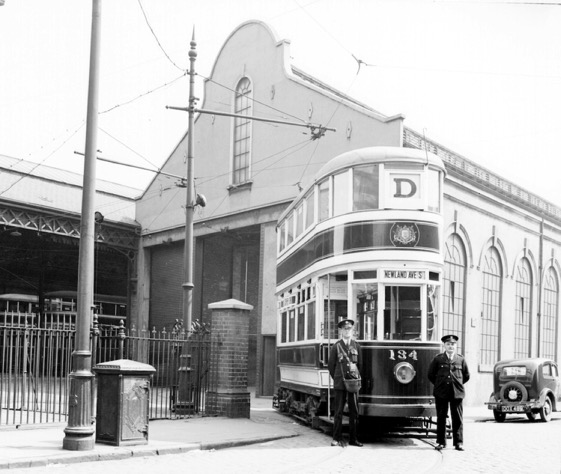
A conductor and a motorman pose with Tramcar No 134 outside the depot on 22nd May 1938. Photographer, W A Camwell. Photo courtesy of the National Tramway Museum. 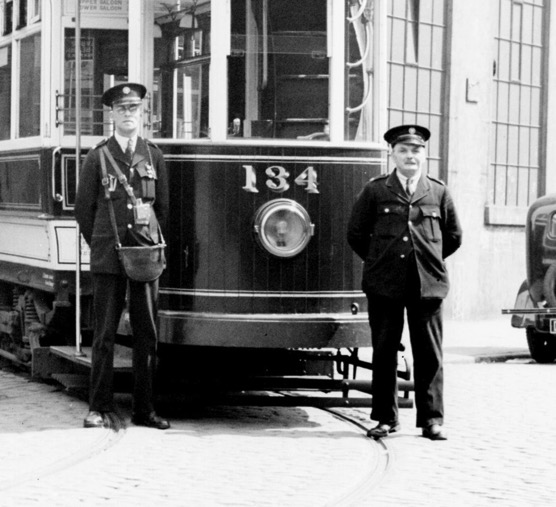
An enlargement of the above photograph showing the crewmen's single-breasted jackets (with lapels) and the round cap badge introduced after the Great War. 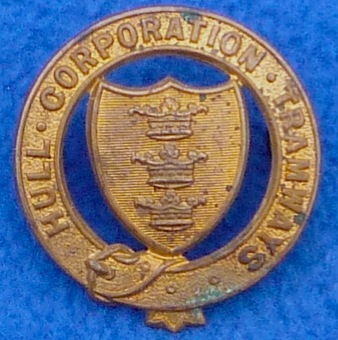
Hull Corporation Tramways cap badge — gilt/brass; probably issued to tramway staff from shortly after the Great War until 1932 or thereabouts. Author's Collection.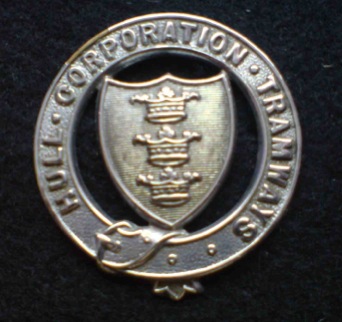
Hull Corporation Tramways cap badge — nickel; probably issued to tramway staff from shortly after the Great War until circa 1932, though doubtless in use for a long time after that.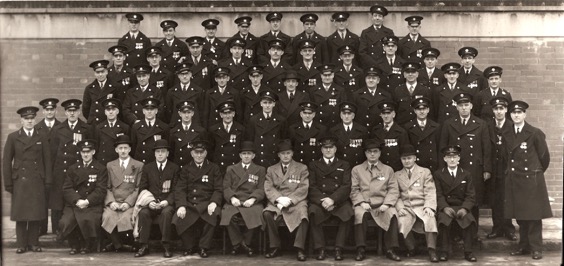
Hull Corporation Transport staff photograph — undated, but probably taken after the demise of the tramway given the plethora of WW2 medals on display. Photo courtesy of Memory Lane Images.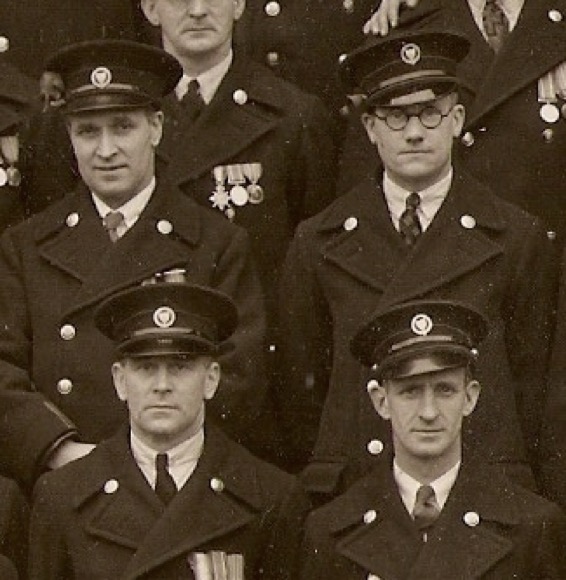
An enlargement of the above photograph showing a group of four drivers/conductors.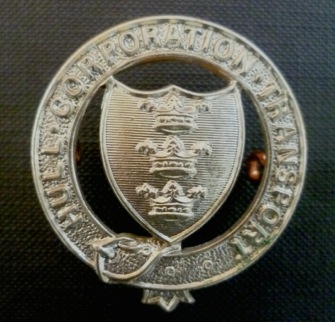
Hull Corporation Transport cap badge — nickel; almost certainly issued to tramway staff from circa 1932 to 1945. Author's Collection.
Senior staff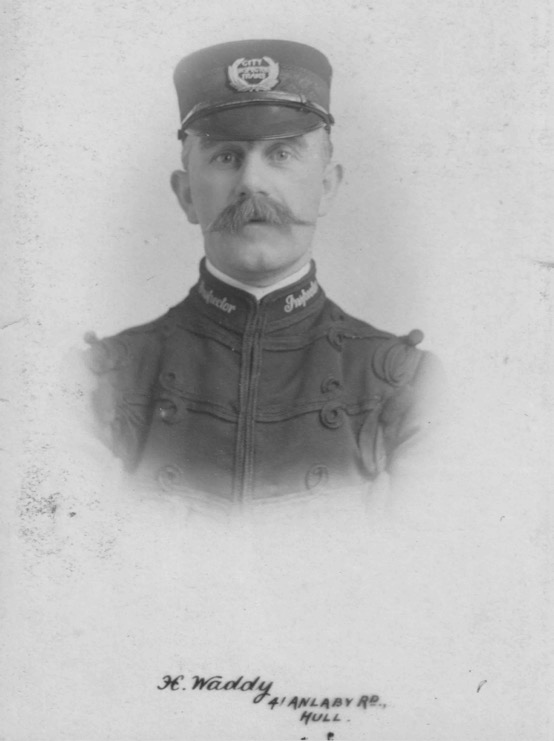
A rare studio portrait of a Hull City Tramways inspector — photo undated, but very probably taken within the first few years of electric operation. The elaborately braided jacket is complemented by a drooping-peak cap bearing a brocade hat band. Photo taken in the studios of H. Waddy, 41 Anlaby Road, Hull. Author's Collection.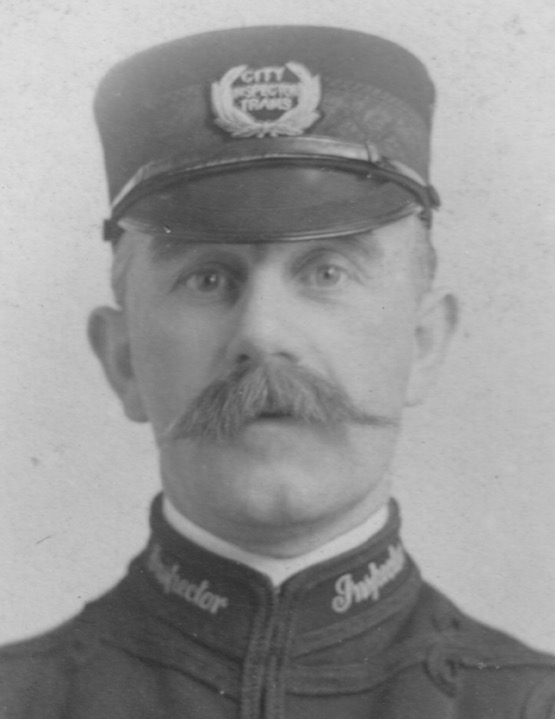
An enlargement of the above photograph showing details of the cap and collar insignia. Both the collar and the cap badges are embroidered, the latter bearing 'CITY INSPECTOR TRAMS'.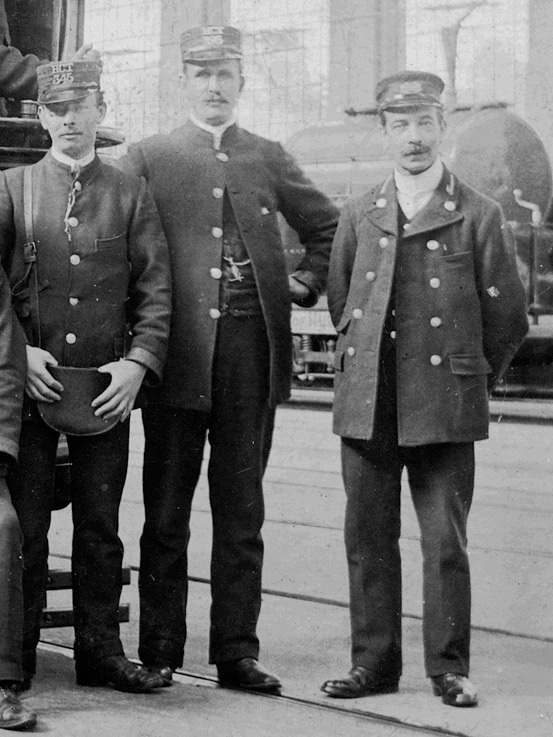
An enlargement of the Cottingham Depot staff photograph above. The figure on the right is probably the Depot Foreman. Photograph courtesy of Paul Gibson (see link).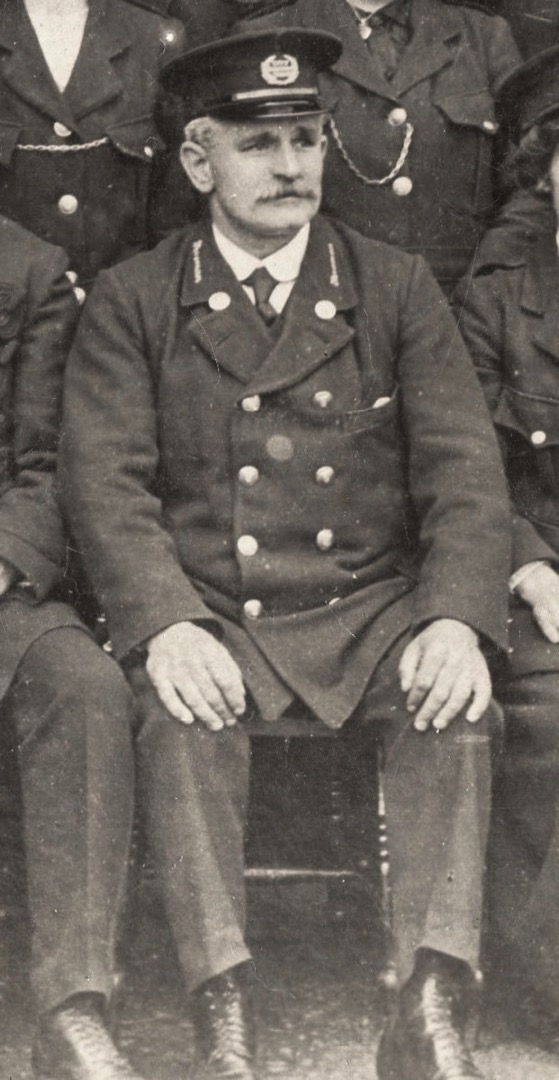
An enlargement of the Great War conductresses depot photograph below, showing an individual who is, in all probability, a foreman. He is still wearing the same style of double-breasted jacket seen in the turn of the century photograph above, though the drooping-peak style of cap had by this time been superseded by a more modern tensioned-crown type.
A studio portrait of a Hull Corporation Tramways/Transport foreman — photo undated, but probably taken in the 1930s given that one of the medals is from the Boer War (my thanks to Alan Owen for the identification). His cap badge incorporates a curved grade badge rather than the horizontal lettering of the earlier badges. His uniform jacket is single-breasted with lapels and epaulettes. Photo courtesy of the Stephen Howarth Collection.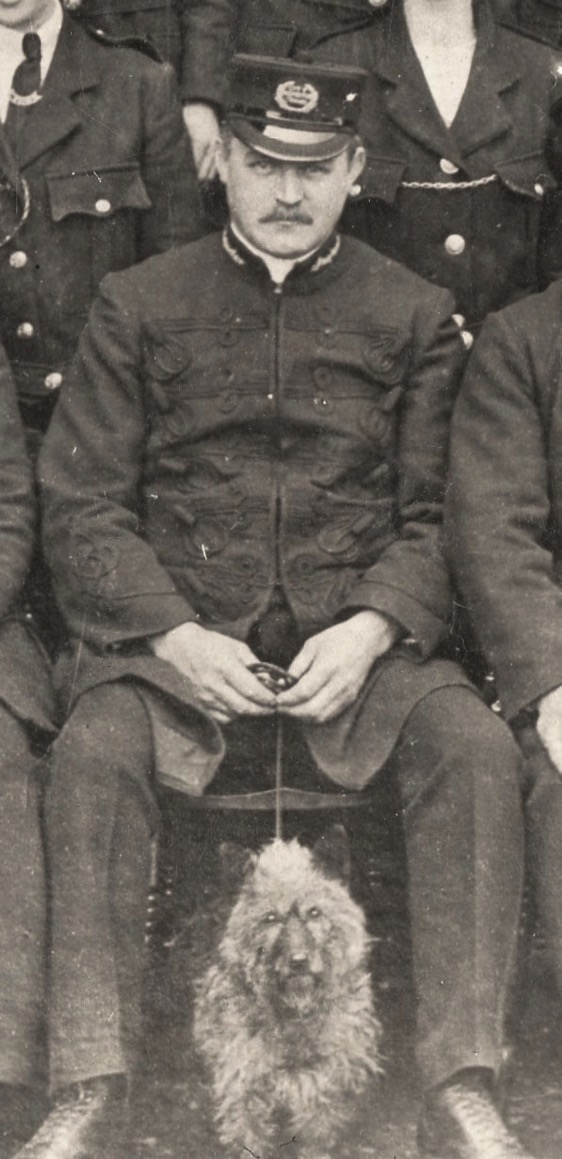
Another blow-up of the Great War conductresses depot photo (see below), showing an individual who is in all probability an inspector.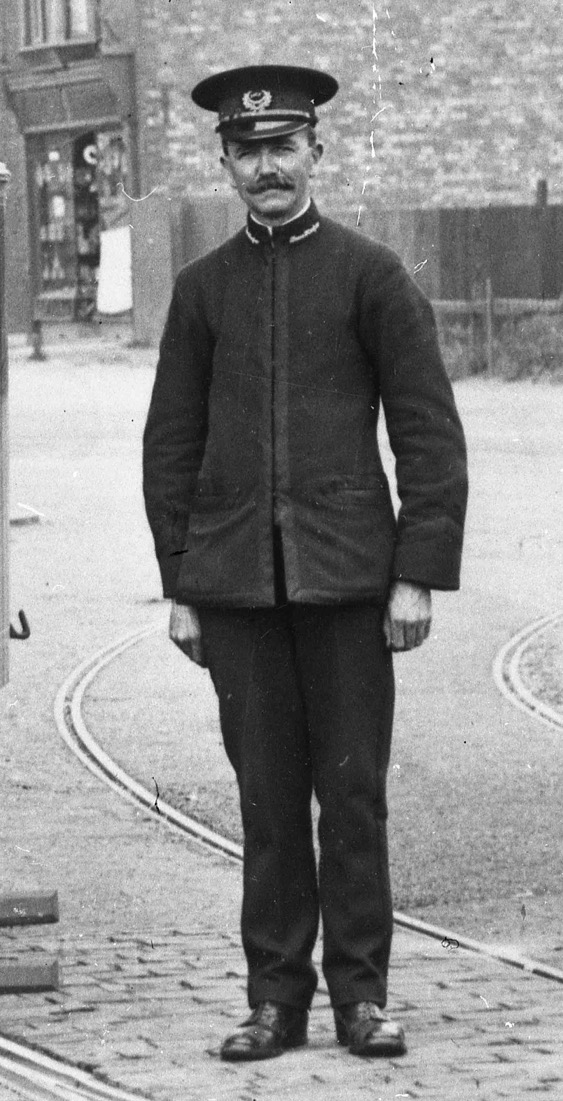
An enlargement of the 1915 photograph of Tramcar No 61 above, showing the senior staff member. His collar designations are difficult to make out, but appear to be consistent with the grade of 'Timekeeper'.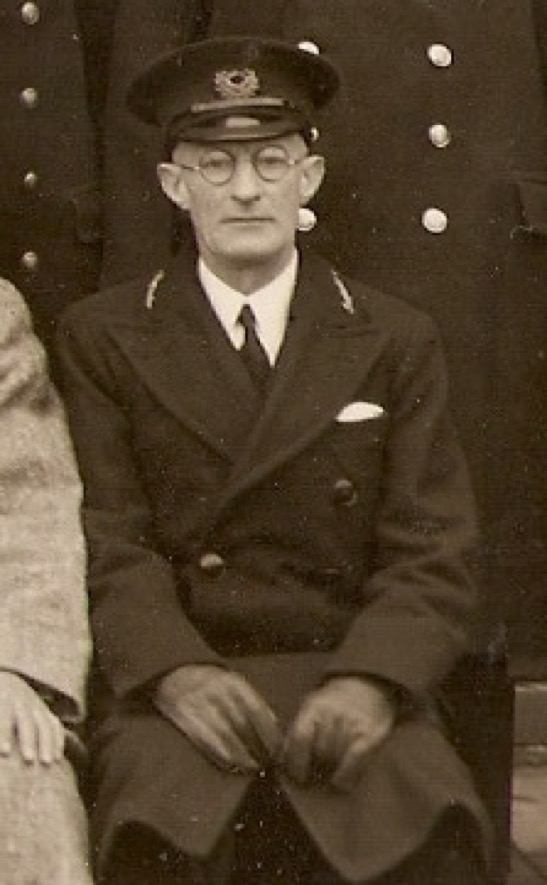
An enlargement of the post-WW2 staff photograph above, showing an inspector.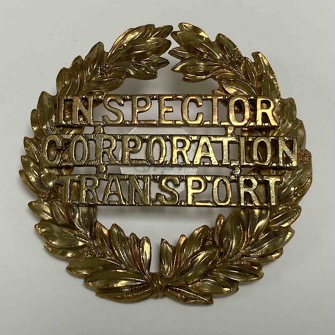
Hull Corporation Transport inspector's cap badge — gilt/brass; photographs strongly suggest that this badge was not worn during the tramway era. Photo courtesy of the National Tramway Museum.
Female staff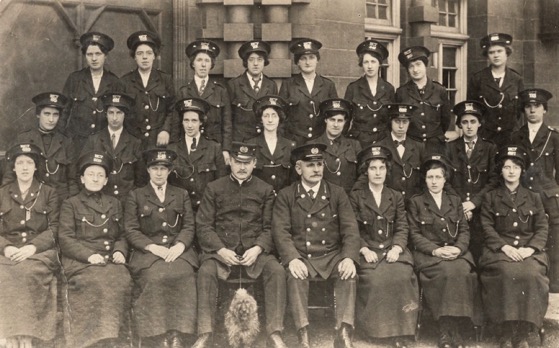
A group of female staff (twenty-two in total) along with two senior uniformed members of staff — photo undated, but almost certainly taken during the Great War. The lady seated second from the right on the front row is believed to be Mary Witty, whilst the lady on the middle row at the extreme left is Alice Henrietta Petersen; both these ladies are pictured in studio portraits below. Author's Collection.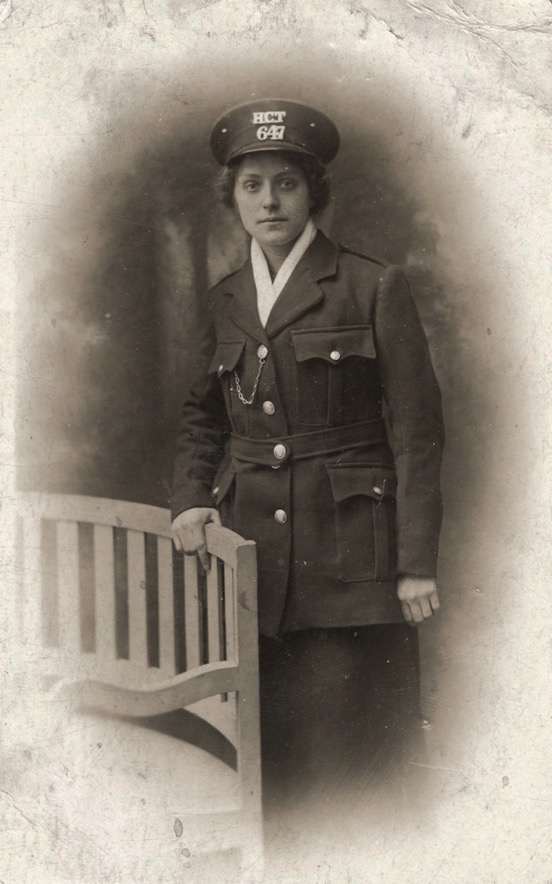
Hull City Tramways Great War female employee (No 647), Mary Witty (nee Ball). Author's Collection.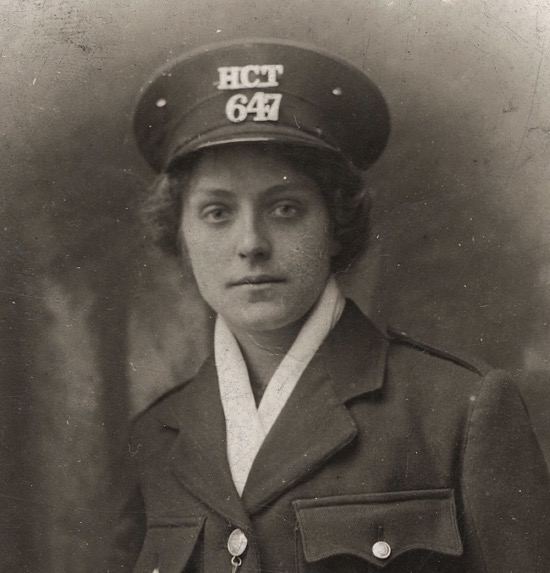
An enlargement of the above photograph, which clearly shows the one-piece nature of the cap badge.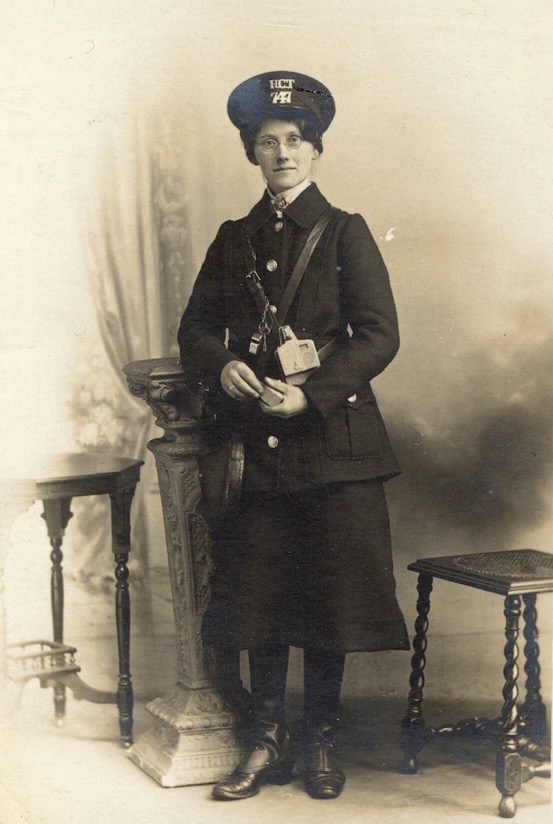
Hull City Tramways Great War female employee (No 747). In contrast to the other photographs, the jacket here has only two pockets and high, fold-over collars rather than lapels. Author's Collection.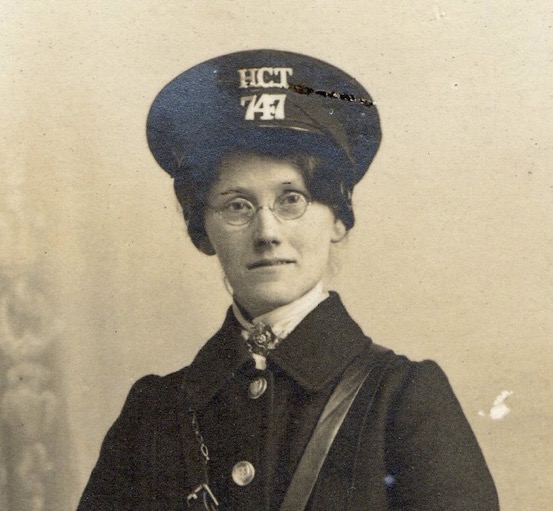
An enlargement of the above photograph, which is sharp enough to show the Hull shield on the buttons.
An inspector and a group of conductresses, including the lady in the previous photograph (Employee No 747), who is seated on the front row, second from the right). Photo courtesy of the Stephen Howarth Collection.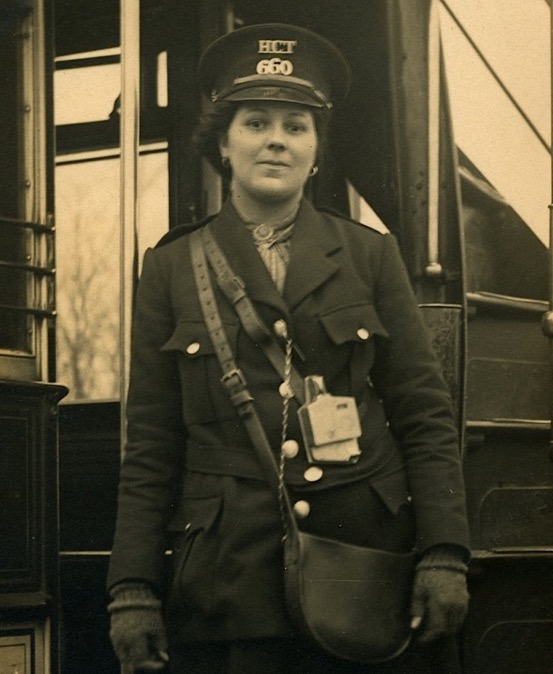
HCT conductress (Employee No 660) — photo undated, but almost certainly taken during the Great War. Photograph courtesy of Paul Gibson (see link).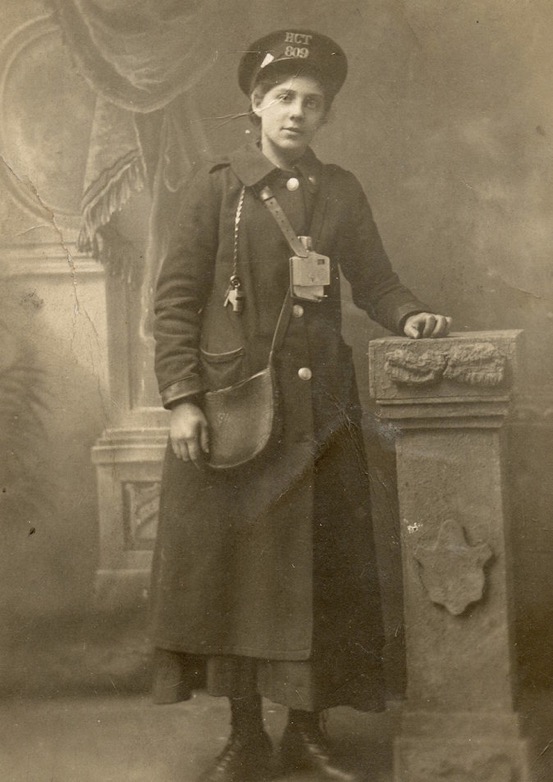
A studio portrait of a Hull City Tramways Great War tram conductress (Employee No 809) in a great coat. Author's Collection.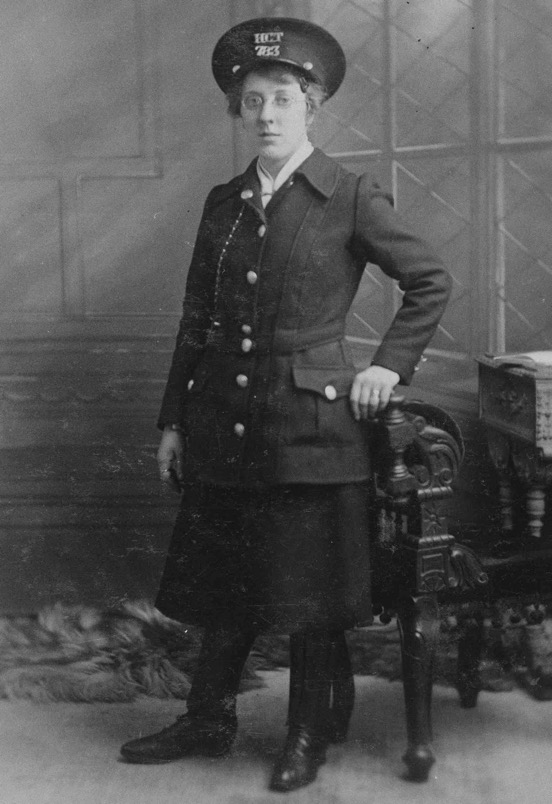
HCT Great War conductress Alice Evans nee Deinty (Employee No 783). Mrs Evans had only been married for a couple of weeks before her husband was killed in the war. Photo courtesy of the National Tramway Museum.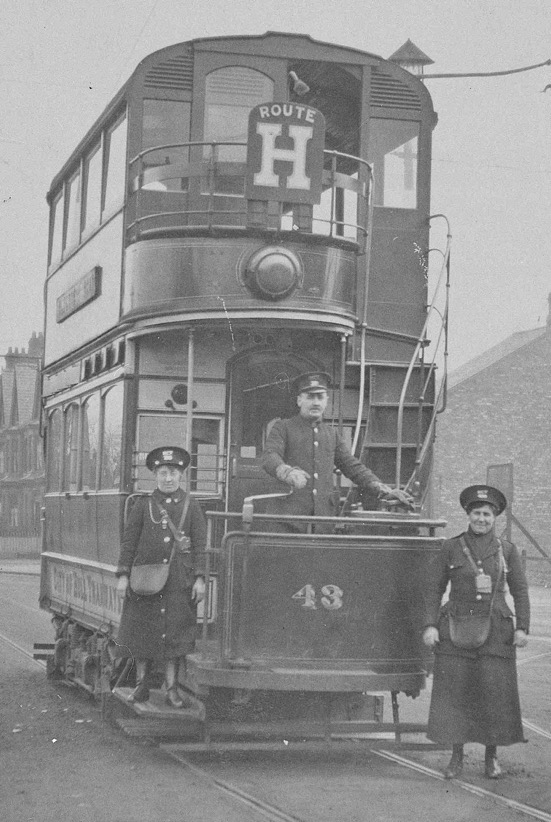
Conductress Alice Evans (left) with her motorman and another conductress aboard Tramcar No 43 — photo undated, but certainly taken during the Great War or shortly afterwards. Photo courtesy of the National Tramway Museum. 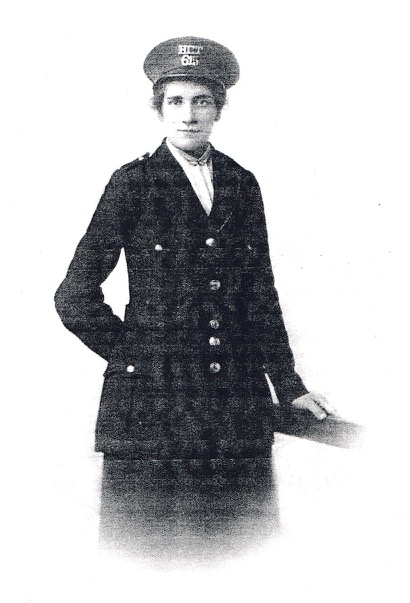
Hull City Tramways Great War conductress Alice Henrietta Petersen nee Rosenqvist (Employee No 615). Photo courtesy of her grand-daughter, Catherine Ager (nee Petersen).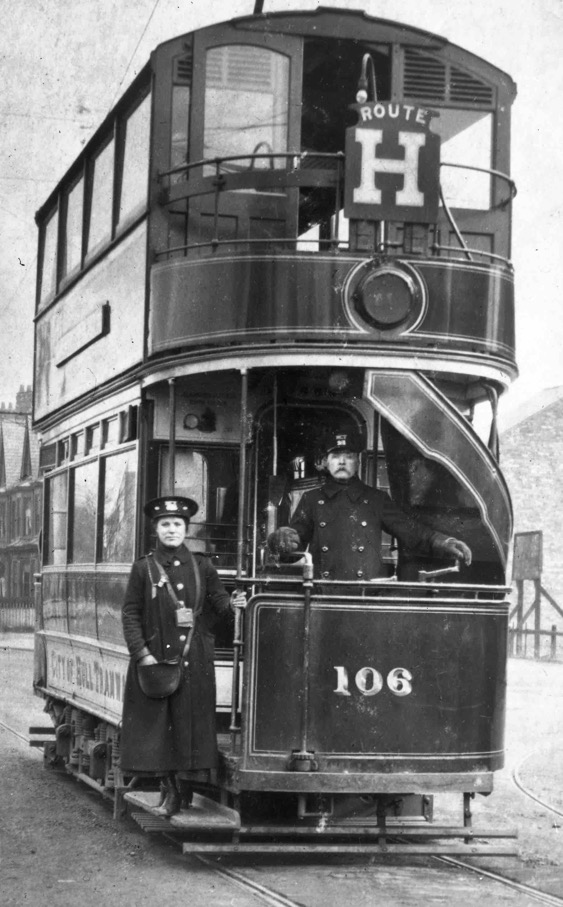
Conductress Edith Davidson and Motorman J H Dawson captured for posterity at the Holderness Road terminus on 25th February 1919. Photo courtesy of the National Tramway Museum.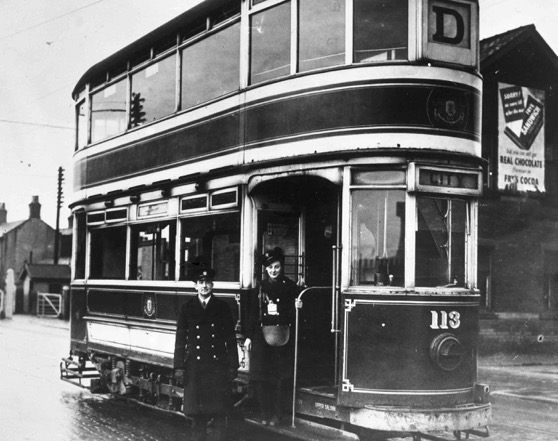
A motorman and a conductress with Tramcar No 113 at Dairycoats on the 1st December 1944. Photo courtesy of the National Tramway Museum.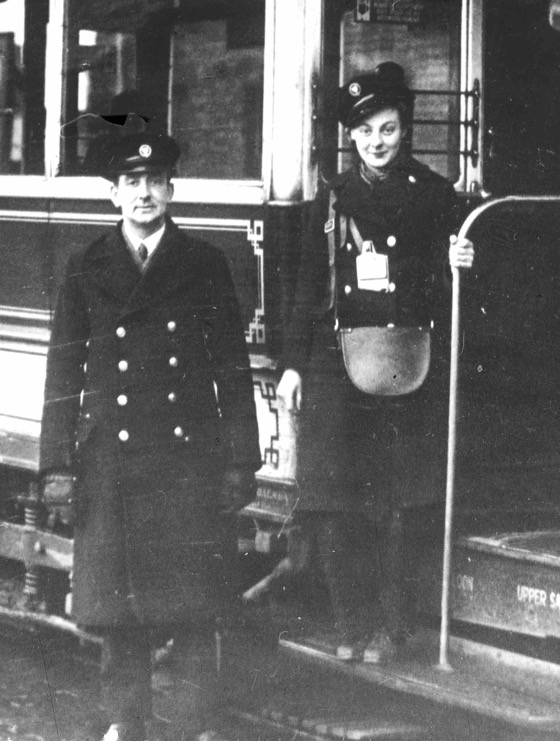
An enlargement of the above photograph showing details of the crew's uniforms. The conductress is wearing a double-breasted topcoat with lapels, seemingly devoid of insignia, along with a baggy peaked cap bearing the standard HCT circular cap badge, presumably bearing 'TRANSPORT' wording by this time.